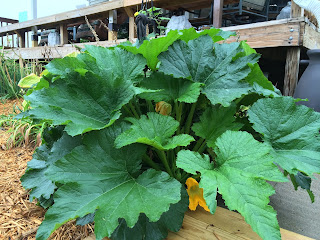 |
| Baby zucchini |
Saturday, July 25, 2015
Zucchini is a summer squash. They love heat, fertile soil, and sustained moisture. You can plant them as soon as all danger of frost is past and they will be producing in just a few short weeks. They go right through until fall if you keep them picked. All plants are programmed to reproduce so if you keep the fruits picked, the plant will keep trying to replace it.
Squash originated in Mexico. There are cave drawings from 8000 to 6500 BC depicting squash. Squash was grown extensively by Native Americans as part of the “Three Sisters” of squash, corn and beans.
Squash love organic matter. If you throw a few seeds in your compost pile, you will be rewarded with exuberant vines.
Zucchini is full of nutrition. It contains antioxidants, carotenes, lutein, folates, potassium, vitamin A, vitamin C, and B vitamins. For more specific nutritional information, Summer squash nutrition info
Plant when nighttime temps are 55F or warmer. Add a fertilizer rich in phosphorous a week after transplanting, when flowers first appear and again when fruits begin to form. They love water, too.
Zucchini can be easily grown in a container, too. Look for compact bush types like Bush Baby, Yellow Crookneck, Eight Ball, Cue Ball, Golden Delight, Anton, Patio Star, Giambo, Astia, Raven, Cosmos Hybrid (look for bush types versus vining types). If growing in a pot, keep well watered and don’t let dry out.
Zucchini can be easily grown in a container, too. Look for compact bush types like Bush Baby, Yellow Crookneck, Eight Ball, Cue Ball, Golden Delight, Anton, Patio Star, Giambo, Astia, Raven, Cosmos Hybrid (look for bush types versus vining types). If growing in a pot, keep well watered and don’t let dry out.
Don’t panic when the first blooms fall off without producing any fruits. There are male and female flowers. If yours falls off, it was likely a poor guy that withered without the love of a gal. There can also be some false starts with malformed fruits. Don’t worry, the plant will put on more blooms and you will be on your way to zucchini overload before you know it!
Give zucchini a mid summer side dressing of fertilizer or compost if planted in the ground. Fertilize every couple of weeks with a liquid fertilizer if in a pot.
If you allow the fruit to get too big, the skin gets tough and the seeds hard. Optimum length is no longer than 6 inches for the juiciest fruit and the smallest seeds. We just picked 2 that were more like a foot long and they were still delicious.
Our favorite preparation is to slice and grill it. We slice them lengthwise, brush on olive oil, dust with sea salt, and put them on the grill with whatever we are cooking as the main course. Grilling or roasting brings out the sweetness in the fruit. Olive oil does not reach smoke temperatures until 350-400F so is still a good choice when grilling below 325.
If they grow large, you can use them for zucchini bread or cut in half, scoop out the seeds, stuff with a sausage tomato sauce and bake until tender.
For more ideas on what to do with an abundant zucchini harvest, check out What to do with all that zucchini?!
For more ideas on what to do with an abundant zucchini harvest, check out What to do with all that zucchini?!
There are a couple of pests that you have to worry about with zucchini-the cucumber beetle, the squash bug and squash vine borer. Cucumber beetle can infect the vine/bush with bacterial wilt. When you see them, pull them off and drop in soapy water.
In late summer in areas with high humidity, you can get powdery mildew. This can be treated by spraying with baking soda, copper or fresh whey. I have found that planting a second plant around the first of July is the best approach. This plant will be kicking in as the second starts slowing down.


You mentioned putting olive oil on the zucchini and cooking them. Did you know that heated olive oil is terrible for our bodies? Olive oil is only meant to be eaten cool, like with salad dressing. May I suggest you use coconut oil to cook zucchini or any food that needs oil for baking or frying?
ReplyDelete